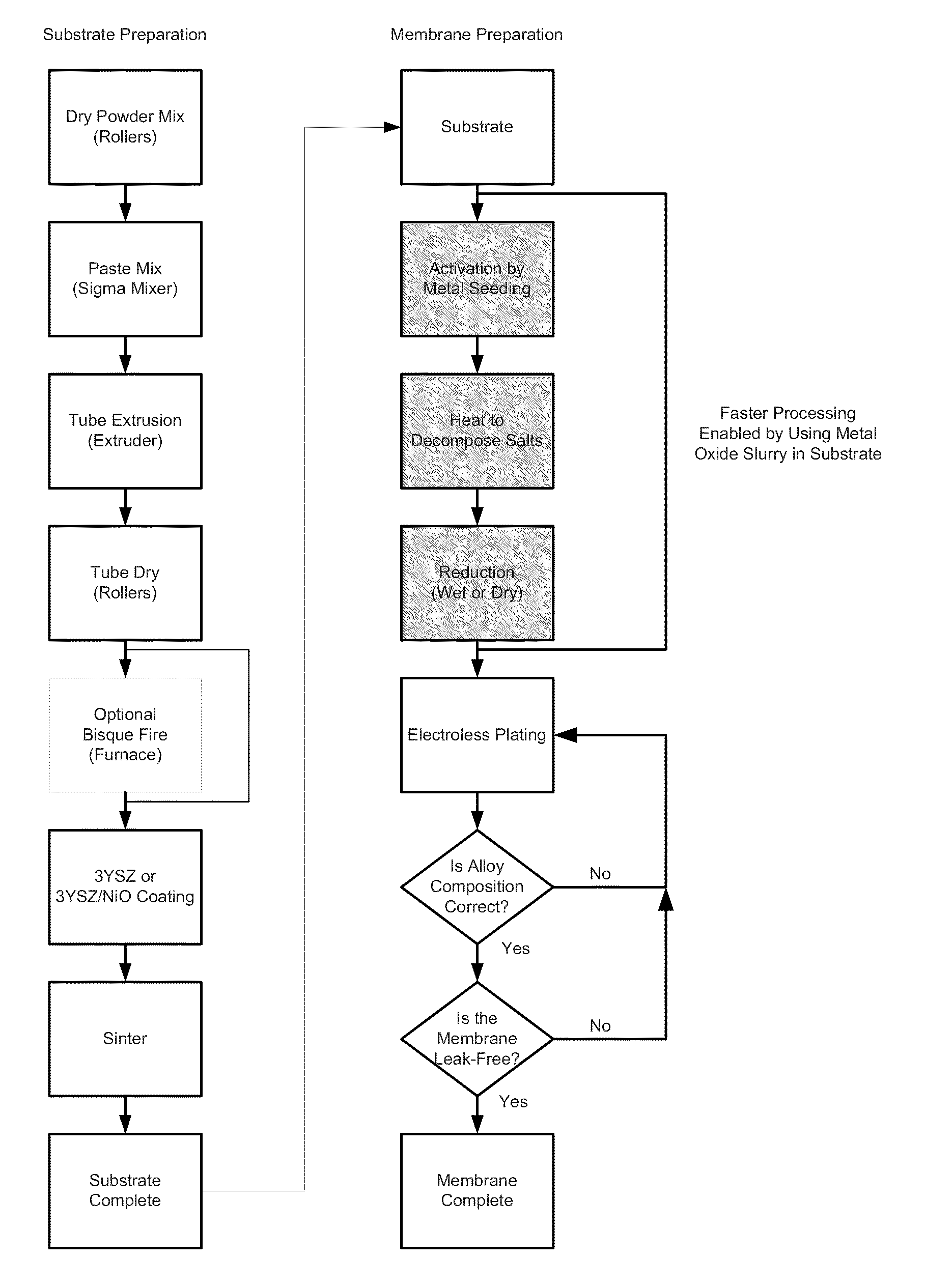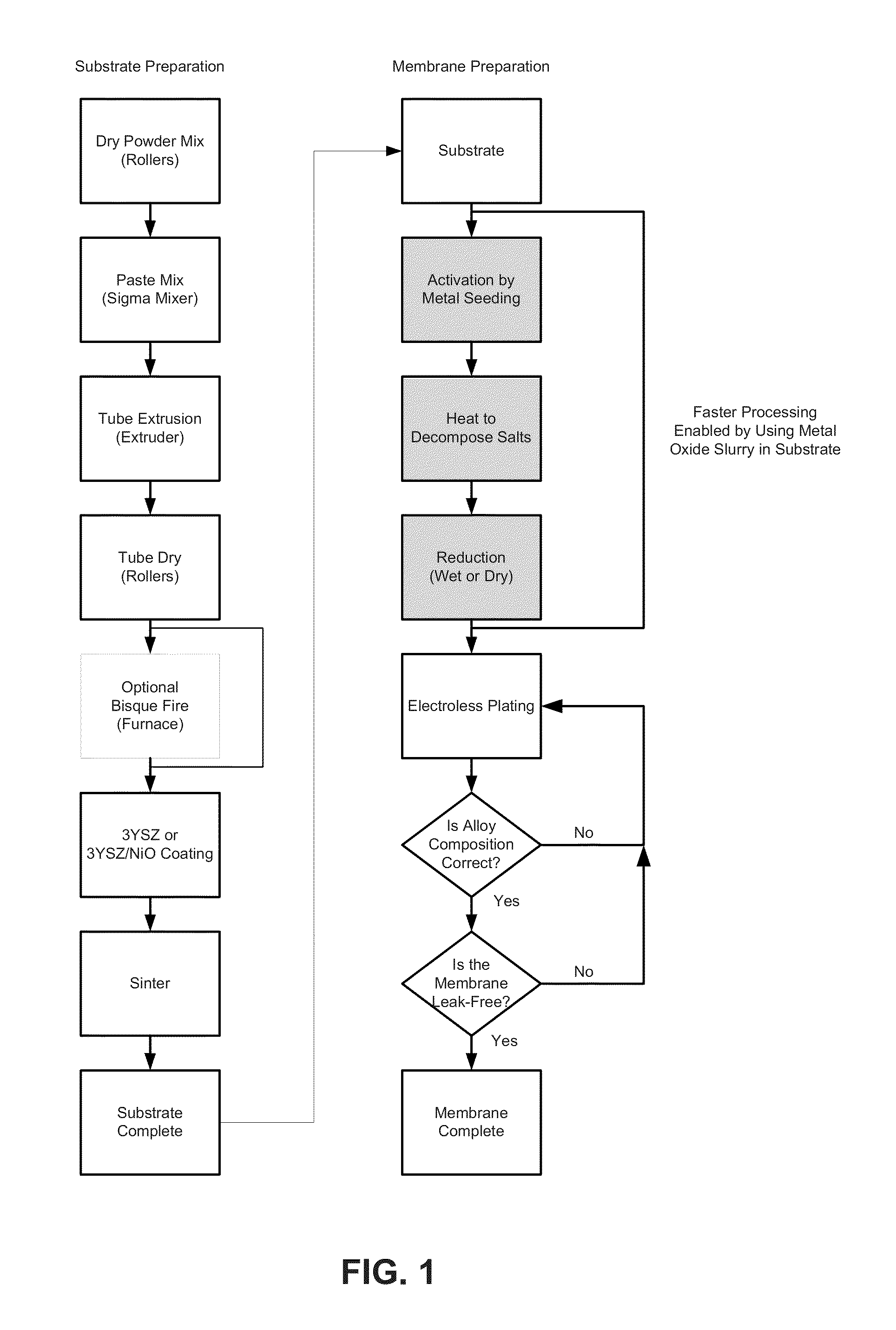Method of making a hydrogen transport membrane, and article
a hydrogen transport membrane and hydrogen transport technology, applied in the field of manufacturing a hydrogen transport membrane and an article, can solve the problems of slow process extending the time for plating, both methods still needed an activation step before plating, etc., and achieve the effect of facilitating an electroless plating process
- Summary
- Abstract
- Description
- Claims
- Application Information
AI Technical Summary
Benefits of technology
Problems solved by technology
Method used
Image
Examples
example 1
Plating without Activation
[0062]In accordance with the above-described process and composition, two ceramic tubes were extruded and produced in the same batch. After extrusion, the tubes were coated with slurry, as described in Table 2 using the method discussed above. The tubes were plated after sintering and were not activated using the activation step described above. These were cut into six pieces to a length of three centimeters each and denoted as S1 to S6. Stationary plating at room temperature without an activation step was carried out on these samples using two plating solutions, A and B, with and without EDTA, which is used as stabilizer. The solution compositions are shown in Table 3, below. Solution A, with EDTA, was utilized with substrates S1, S2, and S3 and solution B, without EDTA, was employed for substrates S4, S5, and S6.
[0063]
TABLE 3Composition of Plating SolutionsSolution ASolution BPdCl2 0.54 g 0.54 gNH4OH 60.4 ml 82.6 mlNa2EDTA 8.88 gN / AH2O161.2 ml161.2 ml
[006...
example 2
Effect of Reduction on Pore Size for a Tube with NiO Particles
[0071]Several other extruded tubes containing nickel oxide particles as seed crystals were prepared. Specifically, extruded ceramic tubes / substrates S7 and S8 were prepared with 25 weight percent nickel oxide, and reduction was carried out through a dry (S7) and a wet (S8) reduction method. S7 was treated in hydrogen at approximately 400° C. for about 20 hours, while S8 was immersed in a reducing solution containing hydrazine, ammonium hydroxide, and water at room temperature for about 6 hours.
[0072]Sample S7 Dry Reduction
[0073]FIG. 2 shows the measured air flow rates through the unplated substrate, S7, at room temperature before and after dry reduction. Dry reduction increased air flow rate by about 20%. This result supports a possible increase in porosity by nickel oxide reduction in hydrogen. Maximum pore size, as measured by a bubble point method, showed a slight increase from 1.0 to 1.1 μm after dry reduction, consis...
PUM
| Property | Measurement | Unit |
|---|---|---|
| mean particle diameter | aaaaa | aaaaa |
| weight percent | aaaaa | aaaaa |
| temperatures | aaaaa | aaaaa |
Abstract
Description
Claims
Application Information
 Login to View More
Login to View More - R&D
- Intellectual Property
- Life Sciences
- Materials
- Tech Scout
- Unparalleled Data Quality
- Higher Quality Content
- 60% Fewer Hallucinations
Browse by: Latest US Patents, China's latest patents, Technical Efficacy Thesaurus, Application Domain, Technology Topic, Popular Technical Reports.
© 2025 PatSnap. All rights reserved.Legal|Privacy policy|Modern Slavery Act Transparency Statement|Sitemap|About US| Contact US: help@patsnap.com



